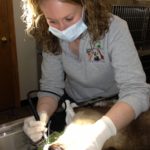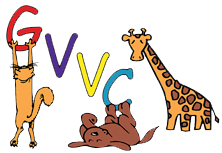 Statistics show that 70-85% of all companion pets over the age of 3 have periodontal disease.We encourage every person with a new puppy or kitten to learn to brush their teeth. If pets are started at an early age, most become accustomed to it. Otherwise, many people wait until we tell them, “Your pet MUST have a dental procedure, and you should expect many extractions.” By then, besides peridontal disease, poor dental care can lead to systemic bacterial overload, tooth loss, and significant bone loss.
Statistics show that 70-85% of all companion pets over the age of 3 have periodontal disease.We encourage every person with a new puppy or kitten to learn to brush their teeth. If pets are started at an early age, most become accustomed to it. Otherwise, many people wait until we tell them, “Your pet MUST have a dental procedure, and you should expect many extractions.” By then, besides peridontal disease, poor dental care can lead to systemic bacterial overload, tooth loss, and significant bone loss.
Adult cats should have 30 teeth and adult dogs 42. Numbers can vary depending on the breed. We understand that many clients are reluctant to have their pet have a dental procedure due to their fear of anesthesia. We would never say anesthesia is without risk. We at GVVC work to minimize the risk by doing the following:
1. Require that a pet have an exam within 6 months of anesthesia.
2. Patients are not only monitored by a trained technician, but extra safety measures include heated procedure tables, respiratory and cardiac monitors.
3. Pre-anesthetic labwork is offered for all dental patients.
Teeth are scaled using an ultrasonic scaler and then polished to smooth surfaces. Patients are sent home with products to use in the weeks following the dental, to help reduce the build up of plaque. We also provide an instructional handout so that clients can learn how to brush their pet’s teeth.
Anything that clients can do at home to maintain the health of their pet’s mouth is beneficial. A few minutes each day spent brushing teeth can save a pet alot of pain and discomfort and also save a client a great deal of worry and financial burden. Just remember-doing something, no matter how small, (chew toys, dental diets, mouth rinses) is better than us “flipping the lip” and finding a disaster.
